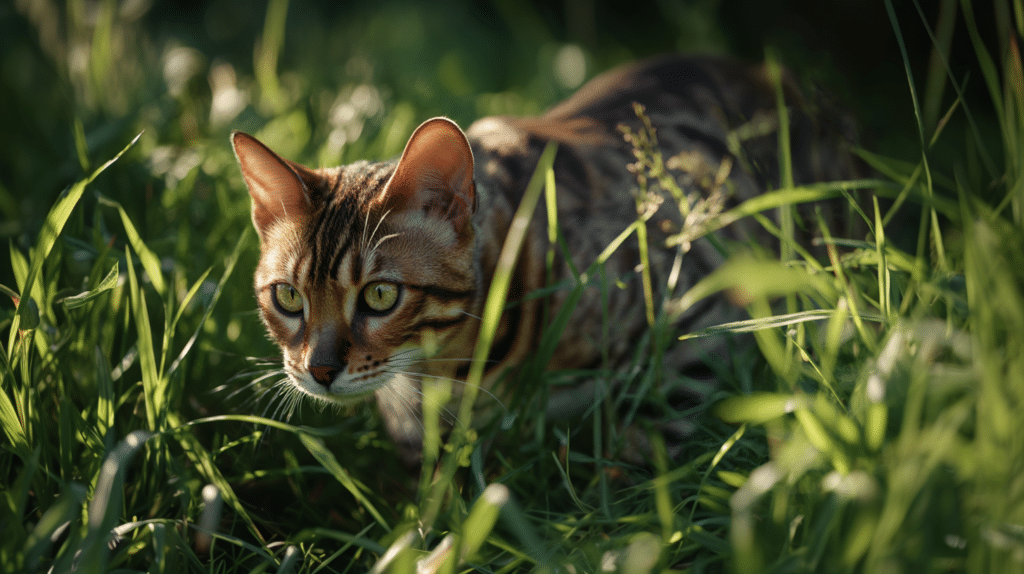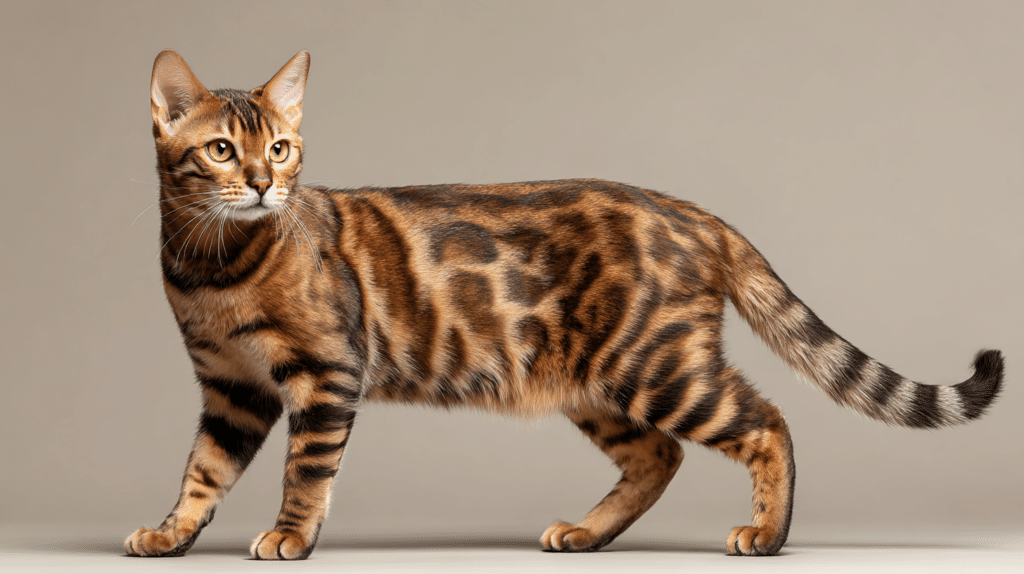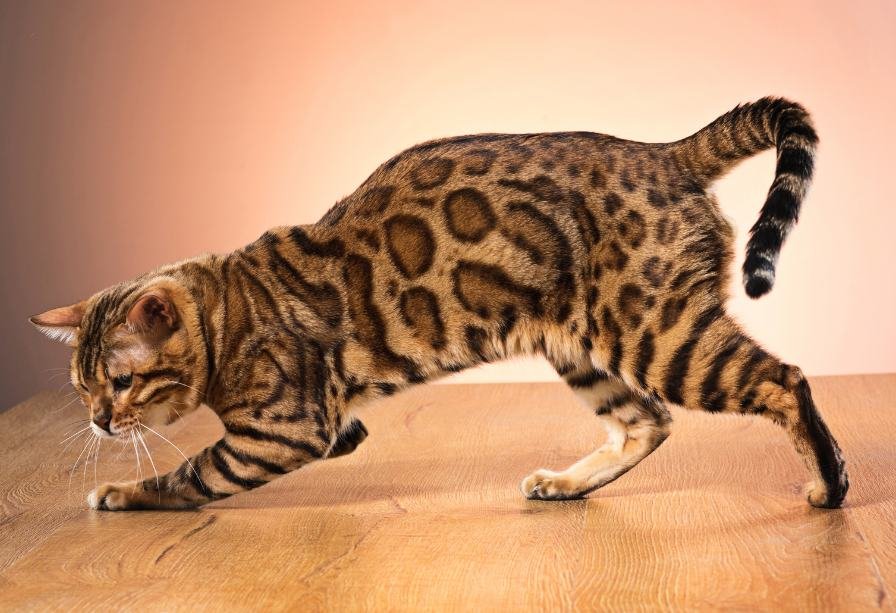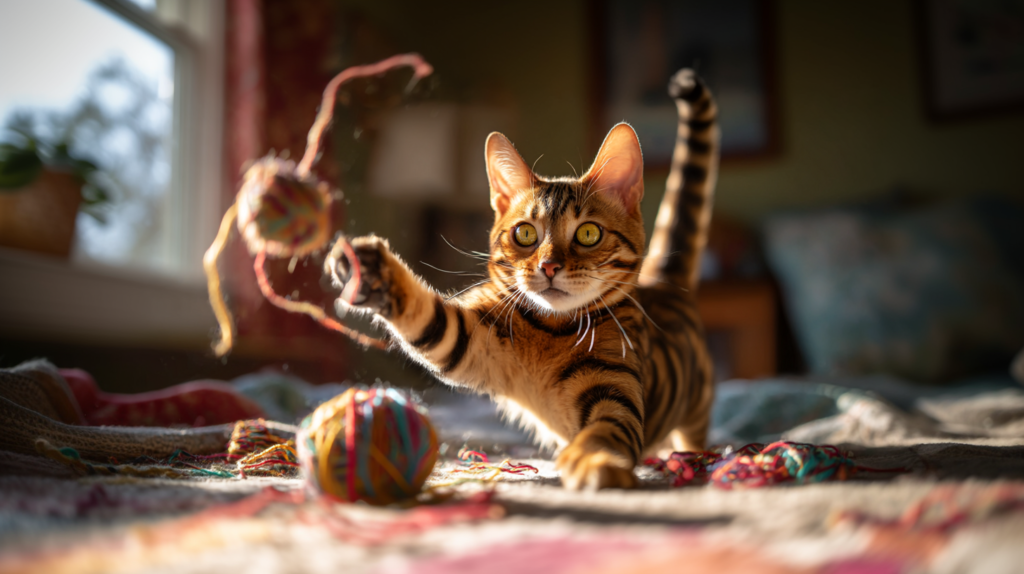

Table of Contents
Introduction
Picture this: You’re sitting in your kitchen when a leopard-spotted cat suddenly appears, not stalking through dense jungle foliage, but leaping onto your counter with the grace of a wild predator. This isn’t a scene from a nature documentary—it’s daily life with a Bengal cat, one of the most extraordinary feline breeds ever developed.
The main question every potential Bengal cat owner faces is this: Can a breed that looks this wild truly thrive as a family pet? The answer reveals a fascinating story of scientific innovation, careful breeding, and the remarkable adaptability of felines.
Bengal cats consistently demonstrate behaviors that would seem impossible in most cats—greeting owners at the door, following family members throughout the house, and even learning to fetch. These dog-like qualities make them stand out dramatically from traditional feline companions.
Understanding Bengal Cat Heritage
The Scientific Breakthrough
In 1963, geneticist Jean Mill embarked on an ambitious experiment that would revolutionize feline breeding. Her goal wasn’t simply to create a beautiful cat—she wanted to prove that humans could capture the stunning appearance of wild felines while preserving the gentle nature that makes cats perfect companions.
Mill’s work began with Kinkin, a female Asian leopard cat (Prionailurus bengalensis) that she crossed with a black domestic tomcat. This first-generation hybrid produced a female kitten that would become the foundation of the entire Bengal cat breed.
AMAZING FACT: It takes at least four generations (F4) before Bengal cats develop the reliable temperament suitable for family life. Today’s Bengal cats are typically F5 or later generations, meaning they’re far removed from their wild ancestry.
Modern Genetic Discoveries
Recent research from Stanford Medicine has uncovered surprising truths about Bengal cat genetics. Scientists discovered that the distinctive “glitter” effect and intricate coat patterns actually result from domestic cat genes that were selectively enhanced through breeding, rather than traits directly inherited from Asian leopard cats.
Key genetic findings include:
- Coat patterns: Controlled by domestic cat genes, not wild genes
- Glitter effect: Result of selective breeding enhancement
- Temperament: Derived from centuries of domestic cat evolution
- Wild appearance: Achieved through careful genetic selection
Bengal Cat Physical Characteristics
Size and Build

Bengal cats are medium to large-sized felines with muscular, athletic builds that reflect their wild heritage. Their body structure features several distinctive elements that set them apart from typical domestic cats. As one of the most expensive cat breeds in the Philippines, Bengal cats command premium prices due to their unique appearance and complex breeding requirements.
| Characteristic | Males | Females |
|---|---|---|
| Weight | 12-15+ pounds | 8-12 pounds |
| Build | Muscular, athletic | Lean, strong |
| Maturity | 18-24 months | 18-24 months |
Distinctive Coat Patterns
Bengal cats display two primary coat patterns that contribute to their exotic appearance:
Spotted Bengal Cats:
- Large, well-formed spots distributed randomly
- Rosettes with lighter centers
- Leopard-like appearance
- Spots may align horizontally
Marbled Bengal Cats:
- Swirled patches creating marble-like patterns
- Asymmetrical and flowing designs
- Distinct from traditional tabby markings
- Unique to each individual cat
MUST KNOW: Many Bengal cats possess a unique “glitter” effect where their coat shimmers in sunlight, created by light-reflecting properties in their fur.
Bengal Cat Personality and Temperament
Dog-Like Behaviors

Bengal cats are renowned for their dog-like personalities that make them exceptional companion animals. Unlike typical cats who may be aloof or independent, Bengal cats actively seek interaction with their human families and thrive on attention and engagement.
Common dog-like behaviors include:
- Greeting owners at the door
- Following family members around the house
- Learning to fetch and retrieve toys
- Responding to their names when called
- Walking on leashes with proper training
Intelligence and Problem-Solving
Bengal cats demonstrate remarkable intelligence that requires mental stimulation to keep them happy and well-behaved. They excel at puzzle-solving and can learn complex tricks, making them highly trainable compared to many other cat breeds.
However, this intelligence can sometimes lead to behavioral challenges. Understanding common cat behavior problems becomes crucial for Bengal cat owners, as these cats may develop issues when their mental stimulation needs aren’t met.
Intelligence indicators:
- Opening cabinet doors and drawers
- Turning on light switches and faucets
- Learning complex tricks and commands
- Solving puzzle feeders quickly
- Manipulating door handles
AMAZING FACT: Bengal cats can learn to retrieve specific items on command and often enjoy 15-20 minutes of daily training sessions that dramatically improve their behavior.
For deeper insights into feline psychology, exploring secrets to understanding your cat’s behavior can help Bengal cat owners better connect with their intelligent companions.
Bengal Cat Care Requirements
Environmental Needs
Successfully caring for a Bengal cat requires understanding that they need more than basic amenities—they need an environment designed to accommodate their unique behavioral and physical needs. For comprehensive guidance on creating the ideal home environment, the ASPCA’s general cat care resources provide excellent foundational information that applies to all cats, including high-energy breeds like Bengals.
Essential environmental elements:
- Vertical climbing opportunities from floor to ceiling
- Multiple cat trees with sturdy construction
- Wall-mounted shelves creating climbing highways
- Interactive puzzle feeders for mental stimulation
- Hiding spots and observation posts
Exercise and Activity Requirements
Bengal cats require a minimum of one hour of dedicated exercise daily, but this needs to be high-quality, engaging activity rather than passive entertainment. Providing appropriate toys for pet cats becomes essential for meeting their complex enrichment needs.
| Activity Type | Duration | Frequency | Benefits |
|---|---|---|---|
| Interactive Play | 20-30 minutes | 2x daily | Physical exercise, bonding |
| Puzzle Feeding | 15-20 minutes | 2-3x daily | Mental stimulation |
| Fetch Games | 10-15 minutes | Daily | Training, interaction |
| Climbing Time | Ongoing | Throughout day | Natural behavior |
MUST KNOW: Without adequate physical and mental stimulation, Bengal cats may develop behavioral problems like destructive scratching, excessive vocalization, or aggressive play.
Bengal Cat Health Considerations
Common Genetic Conditions
While Bengal cats are generally healthy, their breeding history has concentrated certain genetic conditions that responsible owners must understand. For detailed information about Bengal-specific health concerns, WebMD’s comprehensive guide to Bengal cat health provides valuable insights from veterinary professionals.
Major health concerns:
Hypertrophic Cardiomyopathy (HCM):
- Most serious health concern for Bengal cats
- Affects heart muscle, causing thickening
- Typically affects males between 5-7 years
- Can cause sudden collapse or death
- Regular screening recommended starting at age 2-3
Progressive Retinal Atrophy (PRA):
- Causes gradual vision loss
- Begins with night blindness around age 2
- May progress to complete blindness in 2-4 years
- Genetic testing available for breeding cats
Prevention and Management
For comprehensive information about feline health issues and preventive care, the Cornell Feline Health Center offers evidence-based resources from one of the leading veterinary institutions.
| Health Issue | Prevention Strategy | Management |
|---|---|---|
| HCM | Regular echocardiograms | Medication, diet modification |
| PRA | Genetic testing of parents | Environmental adaptations |
| Patellar Luxation | Weight management | Surgery if severe |
| IBD | Quality diet, stress reduction | Specialized diets |
AMAZING FACT: Genetic testing for breeding cats helps reduce the incidence of hereditary conditions by up to 80% in future generations.
Bengal Cat Nutrition and Feeding
Dietary Requirements
Bengal cats’ athletic lifestyle and muscular build create nutritional requirements that differ from those of more sedentary breeds. Their high activity levels demand nutrient-dense foods that provide sustained energy.
When selecting appropriate nutrition, understanding the fundamentals of choosing the best cat food in the Philippines becomes particularly important for Bengal cat owners who need to support their cats’ high energy requirements.
Nutritional priorities:
- High-quality animal protein (25-30 calories per pound of body weight)
- Essential amino acids from premium protein sources
- Omega-3 fatty acids for coat health and joint support
- Multiple small meals throughout the day
Feeding Strategies
| Feeding Method | Benefits | Implementation |
|---|---|---|
| Puzzle Feeders | Mental stimulation, slower eating | 2-3 meals daily |
| Scheduled Meals | Better digestion, weight control | 3-4 small portions |
| Interactive Feeding | Mimics hunting behavior | Hide food, use toys |
MUST KNOW: Bengal cats need protein sources with biological values above 85% to support their muscle mass and energy requirements.
Bengal Cat Grooming and Maintenance
Basic Grooming Needs
One of the pleasant surprises of Bengal cat ownership lies in their relatively minimal grooming requirements. Their short, dense coat naturally repels dirt and rarely develops mats or tangles. For detailed grooming techniques and professional tips, the ASPCA’s cat grooming guide offers step-by-step instructions that work well for Bengal cats’ specific coat needs.
Weekly grooming routine:
- Brushing: Soft-bristle brush or fine-toothed metal comb
- Nail trimming: Every 2-3 weeks to prevent overgrowth
- Ear cleaning: Weekly inspection and gentle cleaning
- Dental care: Regular tooth brushing with cat-specific toothpaste
Litter Box Management
Bengal cats can be particular about their litter box arrangements, making proper setup crucial for their comfort and your home’s cleanliness. Following proven cat litter training success tips ensures your Bengal cat maintains good litter box habits throughout their life.
Special Considerations
Water fascination:
Many Bengal cats display unusual fascination with water. This trait can make bathing easier when necessary, but requires safety awareness around toilets, bathtubs, and pools.
AMAZING FACT: Bengal cats’ water interest stems from their Asian leopard cat ancestry, as wild leopard cats often play and hunt near water sources.
Frequently Asked Questions
Are Bengal cats good pets for families with children?
Bengal cats can make excellent family pets when properly socialized and their needs are met. Their dog-like personalities and high intelligence make them interactive companions that bond strongly with children. However, they do best with older children who can engage appropriately, and young children should always be supervised during interactions.
How much exercise does a Bengal cat need daily?
Bengal cats require at least one hour of dedicated exercise and playtime daily, with some needing even more activity. This should include interactive play sessions, puzzle feeding, and climbing activities. Without adequate stimulation, they may develop behavioral problems like destructive scratching or excessive vocalization.
Do Bengal cats really love water?
While not all Bengal cats enjoy water, many show unusual fascination with it compared to other domestic cats. They may play in sinks, follow owners into showers, or even swim. This trait likely stems from their Asian leopard cat ancestry, but individual personalities vary significantly.
What health problems are Bengal cats prone to?
Bengal cats can be predisposed to hypertrophic cardiomyopathy (HCM), progressive retinal atrophy (PRA), patellar luxation, and inflammatory bowel disease (IBD). Regular veterinary check-ups and genetic testing of breeding cats help manage these risks.
How big do Bengal cats get?
Bengal cats are medium to large-sized, with males typically weighing 12-15+ pounds and females ranging from 8-12 pounds. Their muscular, athletic build makes them appear larger than their actual weight, and they reach full size by 18-24 months.
Are Bengal cats hypoallergenic?
While no cat breed is truly hypoallergenic, Bengal cats may produce fewer allergic reactions in some individuals due to their short coat and potentially lower Fel d 1 protein production. However, people with severe allergies should spend time with Bengal cats before committing to ownership.
Conclusion
Living with a Bengal cat means embracing a lifestyle that accommodates one of the most remarkable achievements in feline breeding. These cats represent the successful marriage of wild beauty and domestic companionship, creating pets that are both visually stunning and emotionally rewarding.
The key to successful Bengal cat ownership lies in understanding that these cats are partners rather than pets. They thrive when treated as intelligent family members whose needs for exercise, mental stimulation, and social interaction are respected and accommodated.
Bengal cats have proven that careful, ethical breeding can create something entirely new while honoring both wild and domestic ancestries. For those ready to meet their challenges, Bengal cats offer a pet ownership experience unlike any other, bringing the beauty of the wild into our homes while remaining thoroughly devoted family companions.
AMAZING FACT: Bengal cats don’t just adapt to our lives—they enhance them, bringing energy, intelligence, and wild beauty into our daily experiences while forming deep emotional bonds that last a lifetime.
